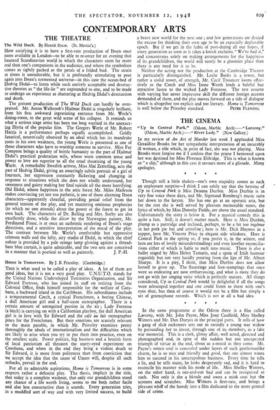CONTEMPORARY ARTS
THE THEATRE
The Wild Duck. By Henrik Ibsen. (St. Martin's.) How satisfying it is to have a first-rate production of Ibsen once more available in London—to be able to re-enter for an evening that haunted Scandinavian world in which the characters seem far more real than one's companions in the audience, and where the symbolism comes as tightly packed as the petals of a folded bud. The strain at times is unendurable, but it is profoundly stimulating to peer again into Ibsen's tormented universe—in this base the ocean-bed of Hedvig Ekdal—to listen while such entirely acceptable and destruc- tive theories as " the life-lie " are expounded to one, and to be made to undergo an experience as shattering at Hedvig Ekdal's destruction and death.
The present production of The Wild Duck can hardly be over- praised. Mr. Anton Walbrook's Hjalmar Ekdal is singularly brilliant, from his first awkward ingratiating entrance from Mr. Werle's dining-room, to the great wild scene of his collapse. It reminds us what a serious stage artist has been too long waylaid in the unexact- ing Illyria of the popular film. The Gregers Werle of Mr. Robert Harris is a performance perhaps equally accomplished. Coldly fanatical, neurotically obsessed by an ideal which has its mandrake roots in his own weakness, the young Werle is presented as one of those characters who have to worship someone to survive. Miss Fay Compton brings a quality of brittle humanity to the part of Hjalmar Ekdal's practical proletarian wife, whose worn common sense and power to love are superior to all the cruel theorising of the young Werle. A remarkable Swedish actress, Miss Mai Zetterling, acts the part of Hedvig Ekdal, giving an amazingly subtle portrait of a girl of fourteen, her expression constantly flickering and changing in response to situations which she does not wholly understand, her sweetness and gaiety making her final suicide all the more horrifying. Old Ekdal, whose happiness in the attic forest Mr. Miles Malleson makes convincing yet not too pathetic, is one of those alarming Ibsen characters—apparently cheerful, providing genial relief from the general tension of the play, and yet muttering ominous prophecies (to which no one attends) about the power of the forest to get its own back. The characters of Dr. Relling and Mrs. Sorby are also excellently done, while the decor by the Norwegian painter, Mr. Ferdinand Finne, is at once an authentic rendering of Ibsen's stage directions, and a sensitive interpretation of the mood of the play. The contrast between Mr. Werle's comfortable but oppressive crimson walls and the lofty, airy studio of Ekdal, in which the chief colour is provided by a pale orange lamp glowing against a thread- bare blue curtain, is quite admirable, and the two sets are conceived in a manner that is poetical as well as painterly. J. P.-H.


































 Previous page
Previous page